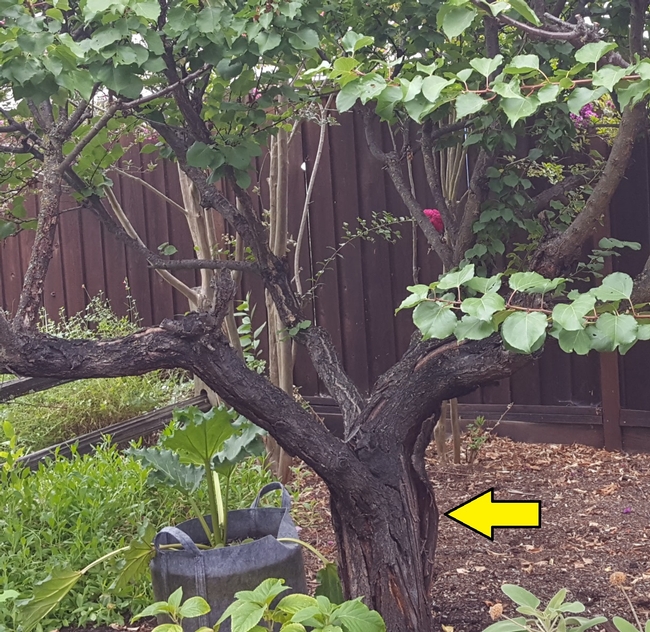Advice for the Home Gardener From the Help Desk of the
UC Master Gardener Program of Contra Costa County
MGCC Help Desk's Response: Thank you for contacting the UC Master Gardener Program Help Desk and for sending the helpful photographs of your apricot tree. The photos show that there is severe bark cracking of major limbs extending all the way to the ground, and at least some sap ooze on smaller branches, although the leaf canopy looks rather healthy. The tree might survive and be fruitful, but because of the extensive damage to the bark and less than optimal branch structure (from improper pruning), taking it out and starting fresh is not a bad idea.
Some additional discussion of issues that could help you make this decision are below.
As we discussed, there is a common fungus disease of apricots call Eutypa die back that is spread by splashing rain and enters through pruning wounds. For this reason, apricot trees should be pruned now (early Fall), never during the wet winter. If you see oozing sites on any branches that are surrounded by sunken areas (indicating an area of infection), or see entire branches dying back, this would indicate your tree has the fungal infection and should be taken out because it will not recover. More information on Eutypa can be found at this University of California website http://ipm.ucanr.edu/PMG/GARDEN/FRUIT/DISEASE/eutypadieback.html.
Another potential cause of the bark cracking is a vigorous and rapid growth response this spring due to last winter's rains, particularly if the tree had not been properly watered during the drought. Since you are just moving in, and do not know the history of tree care, this would be hard to determine. However, if this is the cause, the tree should be able to recover. Providing excellent cultural care for the tree would help it to recover. Apricot trees need summer water every 10 - 14 days, and should also be fertilized in the spring and after harvest as described here http://ipm.ucanr.edu/PMG/GARDEN/FRUIT/CULTURAL/fruitwatering.html and here http://ipm.ucanr.edu/PMG/GARDEN/FRUIT/CULTURAL/apricotfert.html .
If the soil at the drip line of the tree is dry to a depth of 6 inches or more, I recommend that you water it very thoroughly now and again in 7 - 10 days (depending upon whether we have more very hot weather). A soaker hose would work well to provide a long, slow application of water at the dripline that can penetrate the soil. Later, you could provide a light fertilization (half of the recommended amount) to the wetted soil. Never water near the trunk of trees since this can promote infection (described more below).
A third possible cause of the bark splitting is fungal infection of the crown area (transition zone between trunk and roots). The root flare of the apricot tree is not visible in the photos, meaning either that it is covered by mulch (which should be pulled back 4 - 6 inches from the trunk) or that the tree has sunk too deeply into the soil. When the lower part of the trunk is buried in soil, it is very susceptible to rotting by various fungi, which can kill the tree. Bark peeling and loss can be a sign of such fungal infection which would likely have been made worse by the wet conditions last winterhttp://ipm.ucanr.edu/PMG/PESTNOTES/pn74133.html . If you decide to take out the tree and plant a new one, be sure to plant the tree slightly elevated, as described and shown here http://ipm.ucanr.edu/PMG/GARDEN/FRUIT/CULTURAL/fruitnutplanting.html.
Finally, as we discussed, it looks as though the apricot tree was not being pruned properly by the previous owners, but it could be pruned now (early Fall... see above), if you decide to keep the tree. Specific information on how to prune apricot trees can be found here http://ipm.ucanr.edu/PMG/GARDEN/FRUIT/CULTURAL/apripruning.html .
I hope that this information is helpful. Good luck with your new (to you) garden and orchard. Attached to this blog post is short guidance on "Growing a Backyard Orchard" that may be of use to you. Please let us know if you have any further questions.
Help Desk of the UC Master Gardener Program of Contra Costa County (JL)
Please Join us at "Fall for Plants" on September 9 for the workshops and the plant sale.
Registration is optional, but it'll get you a free plant from the sale. We hope to see you there.
Note: The UC Master Gardeners Program of Contra Costa's Help Desk is available year-round to answer your gardening questions. Except for a few holidays, we're open every week, Monday through Thursday for walk-ins from 9:00 am to Noon at 75 Santa Barbara Road, 2d Floor, Pleasant Hill, CA 94523. We can also be reached via telephone: (925)646-6586, email: ccmg@ucanr.edu, or on the web at http://ccmg.ucanr.edu/Ask_Us/ MGCC Blogs can be found at http://ccmg.ucanr.edu/HortCoCo/ You can also subscribe to the Blog (//ucanr.edu/blogs/CCMGBlog/).
Attached Files: